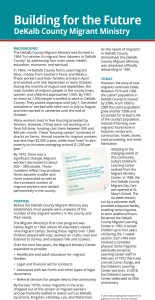Text:
Building for the Future
DeKalb County Migrant Ministry
BACKGROUND
The DeKalb County Migrant Ministry was formed in 1964 “to minister to migrant farm laborers in DeKalb County” by addressing four main areas: health, education, economic, and spiritual.
In 1964, 14 DeKalb County farms used migrant labor, mostly from southern Texas and Mexico. These workers and their families arrived in April and worked until late September or early October. During the months of August and September, the total number of migrant people in the county (men, women, and children) approached 1,000. By 1967, as many as 1,500 people travelled to work in DeKalb County. They picked asparagus until July 1, harvested tomatoes or worked with seed corn in July to August, and then worked in canneries until the end of October.
Many workers lived in free housing provided by farmers. However, if they were not working on a farm full-time, housing cost them between $50 and $60 per month. These “housing camps” consisted of shacks on farms. Annual income for migrant workers was less than $2,500 a year, while most lived “in dire poverty on incomes averaging around $1,200 per year.”
By 1972, there was a significant change. Migrant workers decreased to about 200-300 people. These numbers reflect how produce farms became smaller and more automated as well as the increased number of migrant workers who settled permanently in the county.
PURPOSE
Before the DeKalb County Migrant Ministry was established, most people were unaware of the number of the migrant workers in the county and their needs.
The Migrant Ministry’s first core program was Family Night in 1964, where 45 volunteers visited nine migrant camps. During these nights over 1,000 children played with toys, worked on crafts, read and listened to stories, and enjoyed milk and cookies.
Over the next few years, the Migrant Ministry Center expanded to provide:
Healthcare and adult education for migrant families
Legal and financial aid for contracts
Assistance with tax forms and other types of legal documents
Referral services for people new to the community
By the late 1970s, many migrants in the area dropped out of the stream of migrant workers and permanently settled in towns such as DeKalb, Sycamore, Kingston, Hinckley, Lee, and Waterman.
As the needs of migrants in DeKalb County diminished, the DeKalb County Migrant Ministry was dissolved, officially disbanding in 1981.
TODAY
However, the story of new migrants continues today. Between 1970 and 1990 the Latinx* population in DeKalb County increased by 378%. From 1990 to 2000 the Latinx population grew another 150% and accounted for at least 6.5% of the county’s population. Instead of farming, new migrants found work in factories, restaurants, construction, hotels, stores, meat processing, and metal fabrication.
Adapting to the changing needs of this community, today’s Children’s Learning Center evolved from the Migrant Ministry Center. In 1968, the first DeKalb County Migrant Day Care was opened at St. Mary’s School. The six-week session, run by a volunteer staff, provided a daycare facility, enabling some migrants to work additional hours. Renamed the DeKalb County Migrant Learning Center in 1969, it served children up to four years old during the 11-week session. Each child even received a complete physical. Some migrants eventually served as Learning Center staff. In February of 1972 there was one last name change, and the Children’s Learning Center was born. In 2018, the Children’s Learning Center celebrated its 50th anniversary.
* Latinx is the accepted gender neutral term for populations from Latin American countries
Inset:
July 12, 1978
Illinois Migrant Ministry
Dear Linda and Everyone
I think really that don’t have right words for to thank you this biggest help that I ever received in all my life.
I just want adding “God bless you.”
Sincerely,
Hector Borunda




